An AmericasBarometer Insights Series Report1
With Mexico and Chile restoring diplomatic relations with the administration of President Porfirio Lobo this week, many are beginning to hope that the diplomatic fallout surrounding the June 2009 coup in Honduras may be coming to an end. Unfortunately, based on surveys we have conducted, within Honduras the long-term effects seem far from over. While a majority of Hondurans believe that events of June 28, 2009 removing then-President Manuel Zelaya were a coup and levels of dissatisfaction with the government that preceded the events have declined, the coup and its outcome appear also to have opened a stark difference between socioeconomic classes and their support for democracy.2 The coup and its resolution appear to have had what we call a cathartic effect for a larger number of upper class Hondurans—decreasing their levels of dissatisfaction with democracy—much more than for poorer Hondurans, whose support for coups is lower than the upper classes. The risk is that the elites have come to see the removal of the president such as occurred in June 2009 as a legitimate and effective way to vent their opposition to economic policies.
Background
As early as 2004 Honduras demonstrated “greater risk for unrest, political turmoil, and support for antidemocratic regimes than [did] the other countries,” according to a study by John Booth and Mitchell Seligson using 2004 AmericasBarometer data. At the time, political legitimacy in Honduras was very low compared to legitimacy levels in its neighbors in Central America.3 This was based on a combination of measurements of satisfaction. The concept measures levels of satisfaction in three key dimensions of political legitimacy: 1) support for democracy; 2) support for national institutions; and 3) evaluation of the incumbent government’s economic performance. We combine them and the proportion of citizens who are below the midpoint scale on all three key dimensions of political legitimacy are “triply dissatisfied.”
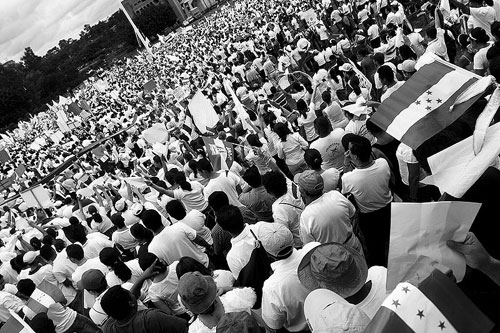
Protests against Manuel Zelaya in Honduras, July 2009 (Credit: Roberto Breve/Flickr)
In past work, Booth and Seligson compared the proportions of triply dissatisfied versus triply satisfied for each country, which they argued could demonstrate a proclivity toward political stability or unrest. Their theory did not assert that having dissatisfied citizens was in itself a problem for democracy, since disaffection can be healthy for democracy. Rather they argued that the balance of dissatisfied to satisfied citizens is what matters. When times are bad and critics of the system are numerous, a democratic political system also needs supporters who believe in democracy, support the nation’s institutions, and are not overly critical of government economic performance. Absent that key group of supporters, stability can be placed at risk.
Booth and Seligson found that in 2004, for every triply satisfied citizen, Honduras had 1.57 triply dissatisfied citizens. In contrast, for every triply dissatisfied Costa Rican there were 12.5 triply satisfied ones.4 We concluded that this strongly suggested that as early as 2004 Honduras demonstrated “greater risk for unrest, political turmoil, and support for antidemocratic regimes than [did] the other countries based on this indicator”
By 2008, AmericasBarometer survey data showed that Honduras’ risk of political instability had risen sharply in four years. The proportion of triply dissatisfied Hondurans went from 12 percent in 2004 to over 31 percent of the voting-age population in 2008, and there were over six times more triply dissatisfied Hondurans than those who were triply satisfied. These survey data from 2008 pointing to growing disaffection among Honduran citizens illuminated the context in which political conflict emerged and boiled over in 2009. The events leading up to President Zelaya’s ouster, and those of June 28, 2009 have divided Honduran society and generated intense debate about the constitutionality of Zelaya’s policies and the actions taken by the military, Congress, and the courts.
The 2010 AmericasBarometer survey in Honduras5 asked a series of questions related to the political crisis. First, we asked a series of questions to measure attitudes directly related to the political crisis: Did Hondurans in our survey conducted in early 2010 support the ouster of President Zelaya? Did they express support for the policies Zelaya wanted to implement? Did they believe that either president or the Army behaved unconstitutionally?
In response to our first question, we find that 58 percent of voting age Hondurans opposed the removal from office of President Zelaya.6 We also wanted to know how Hondurans reacted to Zelaya’s expatriation, an action that is explicitly prohibited by the constitution.7 Probing more deeply, we found that opposition to the exile was even greater, with 72 percent of voting aged respondents in the AmericasBarometer 2010 survey expressing opposition.
Opponents of President Zelaya and some constitutional scholars have argued that the actions of the military did not in fact constitute a coup d’etat. President Zelaya’s supporters and others say that this was a clear case of an unconstitutional and unjustifiable coup.
How did the average Honduran weigh these two positions? The results of the AmericasBarometer survey for 2010 reveal that a majority of Hondurans believe that Zelaya’s removal was indeed a coup. Over 61 percent said the actions taken by the military on June 28 constituted a coup.8 They held to this position even though large majorities also expressed opposition to Zelaya’s intended reforms. Indeed, more than 70 percent of Hondurans were opposed to his proposed constituent assembly (at least in early 2010) and over 75 percent were against the “consulta” that Zelaya had wished to carry out. President Zelaya repeatedly and forcefully denied that his reforms would have included presidential reelection.9 However, the opposition claimed that reelection was the key constitutional change sought by Zelaya and his supporters. This debate between Zelaya and those who supported his ouster notwithstanding, the 2010 AmericasBarometer survey reveals, however, that almost three quarters of Hondurans opposed changing the Honduran constitution to allow for presidential re-election.10
What happened to the triply dissatisfied citizens?
The removal of President Zelaya, and the subsequent national elections that took place in November 2009 seem to have been cathartic for the Honduran population in terms of their levels of dissatisfaction with the legitimacy of their political system in the period before the coup. FIGURE 1 shows that by early 2010 the mean national Honduran score on the triple dissatisfaction index had declined substantially from the peak observed in 2008.11 It had dropped from its high of 1.3 in 2008 to 1.0 in 2010. This level was still far higher than that found in neighboring Costa Rica, but among Hondurans it represented a sharp decline from 2008.
But what specifically had changed? Had Hondurans become on average more democratic, more institutionally supportive, or happier about the performance of their administration in handling the economy?
FIGURE 2 breaks down the triple dissatisfaction index into its components and follows them over time. It reveals that discontent was quite widespread in 2008. That year levels of support for regime institutions, support for democratic principles, and evaluation of regime economic performance were at or near their lowest observed levels in this time series. FIGURE 2 also reveals a recovery of each of these components of regime legitimacy in 2010 after the coup. Support for democratic principles recovered slightly between 2008 and 2010. Support for economic performance, by far the lowest component of triple dissatisfaction, rose modestly from 2008 to 2010 but remained low (not surprisingly, given the global economic slowdown and the particular problems faced by Honduras as foreign assistance and some foreign investment were reduced after the coup). The evaluation that improved the most was support for institutions, which increased roughly 15 scale points from before to after the coup.
Figure 1. Mean Levels of Triple Dissatisfaction
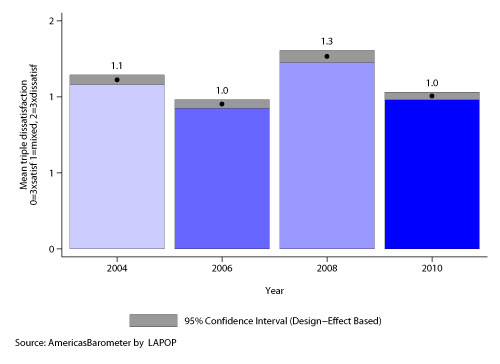
Figure 2. Components of the triple dissatisfaction index in Honduras, over time.
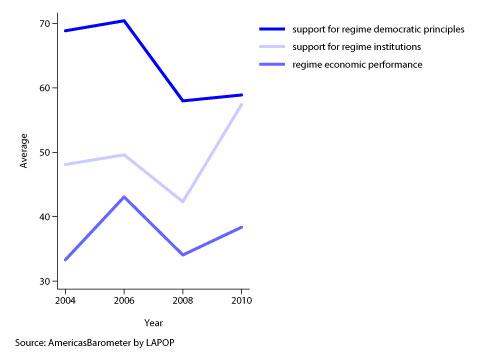
What were the sources of citizen dissatisfaction with government in Honduras?
OLS regression analysis indicates that demographics had an evolving impact on the levels of triply dissatisfied respondents over time. What stands out in this analysis is that the better off were less dissatisfied in 2004 and 2010, but not in 2006 and 2008. That indicates that rich and poor alike were triply dissatisfied in the years immediately prior to the 2009 coup, while after the coup the rich returned to their position of 2004 of being significantly more triply satisfied than other Hondurans [See Table 1].12
Table 1. Predictors of levels of triple dissatisfaction in Honduras, by year*
| Variables | T-scores | |||
| 2004 | 2006 | 2008 | 2010 | |
|
(Constant) |
16.054 | 12.164 | 13.336 | 15.061 |
|
Wealth |
-2.510 | -1.899 | 1.408 | -4.012 |
|
Age |
2.099 | 0.757 | -1.825 | 1.300 |
|
Education |
-0.679 | -1.873 | -3.206 | 1.647 |
|
Female |
0.588 | 1.609 | 0.861 | -0.428 |
|
Size of Community of residence |
3.151 | 1.717 | – 1.387 | 3.012 |
* Shading indicates statistical significance.
Analyzing further the connection between wealth and the triple dissatisfaction indicator provides evidence of the extent to which “satisfaction” with the Honduran regime is rooted in social class differences.
First, FIGURE 3 clearly reveals the dramatic surge in triple dissatisfaction from 2006 to 2008, followed by an almost as large decline from 2008 to 2010. For 2006 and 2010 mean triple dissatisfaction levels were generally lower as income quintiles rose. For 2008, however, a distinctive curvilinear relationship appears, with lower and higher incomes showing less dissatisfaction than middle income respondents. This reinforces the evidence in Table 1 suggesting a shift in the class basis of dissatisfaction with regime economic performance. Specifically, middle quintile citizens showed much higher triple dissatisfaction than in 2006 or than they would later in 2010. Something clearly happened between 2006 and 2008.
Figure 3. Triple dissatisfaction levels by year and levels of wealth

What was the relationship between Hondurans’ economic class position and their satisfaction/dissatisfaction with the regime in 2010, some 8 months after the coup? Looking at the three components of the triple dissatisfaction measure, FIGURE 4 indicates that one, citizens’ evaluations of regime economic performance, was closely linked to economic class standing. In 2010, with the new administration in power, elites were more supportive of the economic performance of the regime than those in lower wealth quintiles. Elites also expressed far more support for coups than Hondurans in lower income quintiles, which suggests that the coup may have proved satisfactory to the interests of wealthier Hondurans.
Figure 4. Legitimacy norms and coup justification in 2010, by levels of wealth
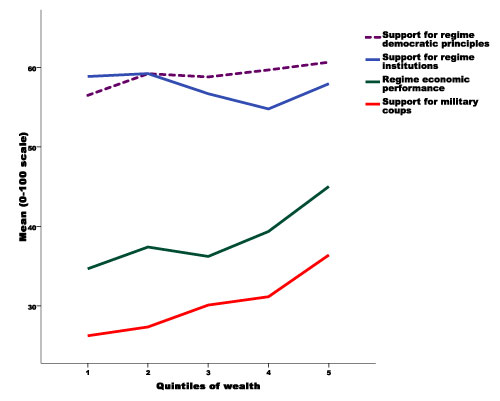
What demographic factors determine support for coups?13
The regression analysis shown in FIGURE 5 indicates that wealth and education were significant determinants of support for coups in 2010. Wealthier Hondurans expressed higher support for coups, while Hondurans with lower levels of education expressed higher support for coups. These results suggest a combination of low education and high wealth may be lethal for democracy in Honduras, and perhaps elsewhere.
Figure 5. Determinants of Support for Coups, 2010
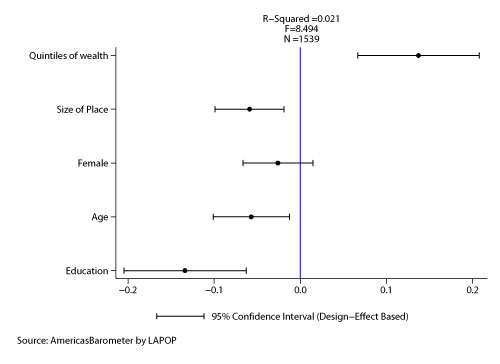
FIGURE 6 reveals higher support for coups in 2008 (the blue bars) than in 2006 (the green bars), indicating a rise in displeasure with the Zelaya administration. As in FIGURE 3, we also observe curvilinear effects. In 2006, support for coups was substantially elevated among Hondurans in the middle quintiles of income, and the pattern was similar in 2008. For 2010 (the red bars), however, we observe a precipitous pattern change — a great drop in coup justification from 2008 for all wealth quintiles. Other patterns are worth noting. By 2010 the curvilinear patterns of coup justification by wealth level seen in 2006 and 2008 had disappeared. The wealth-coup justification relationship had become linear and positive. In 2010—following the coup of 2009—support for coups had declined substantially from 2008, from about 51 to 36, for the wealthiest, and from 44 to 23, for the poorest. That still left the wealthiest Hondurans with the highest levels of coup justification and the smallest decline in this attitude of any quintile from 2008, again suggesting that elite interests may have been far better served by the coup than those of lower strata.
There are various ways to interpret this overall decline in coup support. One is that a “catharsis” or some purging of pent up emotions could indeed have occurred. Another is to speculate that Hondurans, upon reflection on the coup’s costs (increased domestic conflict and repression, external opprobrium, economic assistance cuts), may have changed their minds about how good an idea a coup might be.
FIGURE 6 also reveals that everyone except the poorest supported a coup more in 2008 than in 2006. The biggest changes occurred among those in the top quintile or the wealthiest, whose support for coups went from 36.8 in 2006 to 51.5 on the 0–100 scale in 2008. However, every wealth group reduced its coup support between 2008 and 2010. The largest decreases seem to be among the middle classes.
Figure 6. Justification of Military Coups by Wealth Quintiles by Year
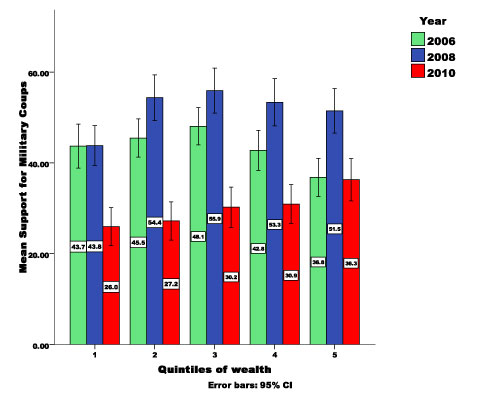
Conclusion
After the tumultuous events of 2009, most Hondurans perceived the events as a coup and opposed both the coup and President Zelaya’s exile from Honduras. However, large majorities nevertheless reported opposing Zelaya’s attempted “consulta” and his proposal for a constituent assembly.
In the wake of the coup, support for institutions rose sharply and evaluation of economic performance increased as well. Hondurans’ support for democratic regime principles, however, by 2010 had recovered very little of the ground lost between 2006 and 2008. This indicates that support for basic democratic principles remain at the levels prior to the coup, thus representing a continued potential threat to stable democratic governance. Between 2008 and 2010 support for coups among the wealthiest cohort of Hondurans declined the least of any economic group. And in 2010 the wealthiest cohort remained the most coup-justifying segment of the Honduran citizenry.
Democratic consolidation is often described as a condition that prevails once citizens and elites of a nation have a generalized embrace of democratic norms and a commitment to constitutional democratic rules as the “only game in town.” Whatever cathartic effect the 2009 coup may have had, or whatever second thoughts citizens may have had about what took place, coup justification remained highest among the best-off Hondurans in 2010 in the wake of months of political trauma, protest, violence, repression and international condemnation. The findings of the 2010 AmericasBarometer survey in Honduras offer little evidence that Hondurans, and especially Honduran elites, view democracy as “the only game in town.”



